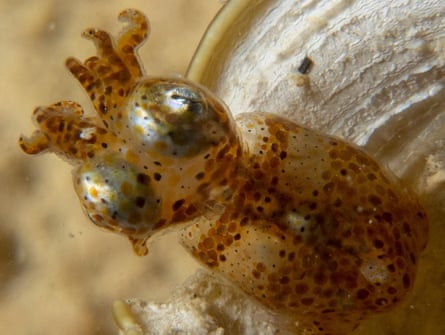A small squid with a powerful grappling technique has been found in the depths of the ocean. It has been dubbed the “sucker-bum squid” due to its unique anatomy and impressive fighting skills.
I
Ancient tales in Japan speak of kodama, mystical creatures that live in the forest. Over time, they have taken on various forms, from invisible beings to tree-like figures. In the film Princess Mononoke by Studio Ghibli, kodama are depicted as round, humanoid creatures with bobble heads. Recently, a type of small squid has been given the name of kodama, paying homage to their role as protectors of nature.
According to Jeff Jolly of the Okinawa Institute of Science and Technology, encountering Kodama jujutsu, a pygmy squid, is an indication of a thriving ecosystem. Jolly and a group of scientists and underwater photographers discovered these squid on coral reefs in Japan and documented their findings in a 2023 research paper.
According to Jolly, the squid are exceptionally small, comparable to the size of a person’s pinky fingernail. These squid belong to the Idiosepiidae family, making them the tiniest cephalopods in the ocean. They are much smaller than their relatives, including octopuses, squid, and cuttlefish. In English, they are commonly known as Hannan’s pygmy squid, named after a diver and photographer named Brandon Ryan Hannan who was instrumental in discovering and gathering them. Due to their minuscule size and nocturnal habits, they are difficult to find.

The Idiosepius kijimuna, also known as the Ryukyuan pygmy squid, is a second pygmy squid species found in the seagrass meadows near the Ryukyu Islands in southern Japan, specifically Okinawa. This particular species was named in honor of the mischievous creatures from Okinawan folklore known as the kijimunā, who are highly skilled at fishing and inhabit banyan trees. Although these pygmy squid were previously identified, a more detailed examination revealed that they are a distinct species.
J
Olly and his colleagues maintained both species of pygmy squid in tanks, and found that their survival rate was significantly higher compared to larger cephalopods. Captive octopuses are well known for their solitary behavior and have a tendency to be aggressive towards one another.
While observing the pygmy squid up close, the team observed behaviors that would have been challenging to track in their natural habitat. According to Amanda Reid, a taxonomist at the Commonwealth Scientific and Industrial Research Organisation in Australia who assisted in identifying the new species while working at the Australian Museum, the squids seem to spend a significant amount of time simply sitting. She also notes that they have a sticky patch on their backs that attaches them to blades of seagrass, which has led one colleague to give them the nickname “sucker-bum squid.” Once attached, the squids wait for shrimp to come close enough to grab.
Jolly witnessed Hannan’s pygmy squid hunting shrimp that were considerably bigger than themselves. This experience led him to name them jujutsu, after the martial art, as it exemplifies the principle that a small individual can take on a larger one. Jolly explains, “The idea behind jujutsu is that a tiny person can go on the offensive against someone much bigger. They use tactics such as wrestling and restraining their opponent’s back, much like how the squid behaves.”
The tiny squid known as pygmy squid have successfully reproduced while being kept in captivity. Every type of pygmy squid has a unique and complex mating dance, where they either face each other or the male positions himself below and behind the female. According to Jolly, the squids emit a buzzing sound similar to bees during the ritual.
Jolly has successfully raised two sets of Hannan’s pygmy squid, a possible first for this species. The offspring are relatively large when they hatch and are able to hunt for shrimp right away. However, their lifespan is short, lasting only two to three months.
The two new species bring the total number of known pygmy squid to eight, which live in different parts of the Pacific Ocean. “I think there’s likely to be more species to be described. There’s a few from northern Australia that I’m pretty sure are new species, so we’ll see,” says Reid. “It’s not the end of the story, as far as these little critters are concerned.”
Source: theguardian.com


